
– Craftsmanship is the cultural experience and expertise of design in products made by hands –
India is home to the world’s most hand-skilled artisans and rich in textile heritage.
A heritage of high-end quality craftsmanship and diversity ranging from hand embroidery,
through block printing, natural dyeing, hand weaving, to the mastery of hand spinning.
It is in this magical country and by its skilled artisans where the roots of “Khadi” fabric can be found.
Traditional Khadi is hand-spun and hand-woven, a human process in which all senses work together.
Hand-spun yarns with counts as high as 200, almost invisible to the human eye,
are hand-twisted and -woven into beautiful fabrics.
These techniques can only be mastered by few due to its difficulty.
The quality difference of a thread that is formed between two fingertips epitomises the fabric’s unique
character and identity. That is what makes Khadi fabrics unique in terms of production, and impossible
to compare or copy by machine-made fabrics.
Recognisable and distinguishable from the uniform look of machine-made fabrics by slight irregularities
in the warp and/ or weft; a characteristic effect resulted from the artistry of hand-spinning.
THE MOVEMENT
Apart from its rich texture and striking simplicity, Khadi has a fascinating story, as being central to
Gandhi’s movement in the early 1920’s:
In 1918, Khadi was re-introduced in India as a social & financial empowerment movement to support
craftsmanship and people living in the more remote areas of India. Villagers started to plant and harvest
their own raw materials, while spinning and weaving was elevated to an ideology for self-reliance and
self-governance. Khadi symbolized the need and importance of indigenously manufactured goods.
“Every village shall plant and harvest its own raw-materials for yarn, every woman and man
shall engage in spinning and every village shall weave whatever is needed for its own use”
Gandhi
Since traditional Khadi is made by hands or hand-run machines only, there was little capital required for
the manufacturing. True human skills and craftsmanship was the fuel.
Khadi became not only a symbol of revolution and resistance, but also the face of an Indian identity
and marked the start of a democracy.
THE VALUE OF TIME
A MINIMUM OF 10 SPINNERS ARE REQUIRED TO SUPPORT A SINGLE HAND LOOM
64,000 METERS OF YARN NEED TO BE SPUN FOR 3 METERS OF FABRIC
IT TAKES 1 TO 2 DAYS TO WARP THE LOOM
9 HOURS OF HAND WEAVING ON A WOODEN LOOM EQUALS 2 METERS OF SELVEDGE DENIM FABRIC
NATURAL INDIGO COLOUR FERMENTATION REQUIRES 10 TO 14 DAYS
EACH HANK GROUP IS INDIVIDUALLY DYED BY HAND IN SEVERAL DIPS TO GET THE
RIGHT COLOUR SHADE, STRETCHING THE DYEING PROCESS TO MORE THEN 10 DAYS
THE SOCIAL CHAIN
The Seven Senses journey starts in the villages of north India, and region of Bihar. Where a few hundred
artisans, majority of whom are women, are involved in the art of hand spinning. Traditional box Charkhas
as well as New Model Charkhas (NMC) are used to hand-spin the pure cotton into the finest yarns.
The art and craft of hand-dyed natural indigo is an intense process that takes place in the city of Bhagalpur.
In this same city our Seven Senses Fabrics also received their different finishes. After first being washed
with natural soap nuts the fabric can be finished in three different ways:
‘Loom-state one dip’:
the fabric is soaked for one night in water keeping some of the starch but reducing the shrinkage.
‘Calendered’:
for a softer touch and more brilliant colour effect the fabric is passed through steel rollers.
‘Kundi’:
a traditional Indian method where the fabric is hammered meter by meter with a wooden mace.
This gives it an extra silky look and softens again the touch.
To highlight the cultural and historical identity of our Social Chain, we offer upon request silver or golden
recycled Zari threads that can be woven into the selvedge of our denim fabrics.
Such human processes put a limit on production capacity, but at the same time enhance the exclusivity
of every meter of fabric. With its rich texture and personality, Seven Senses Handwoven Denim fabrics
have delicate detailing and are unique for their human touch.
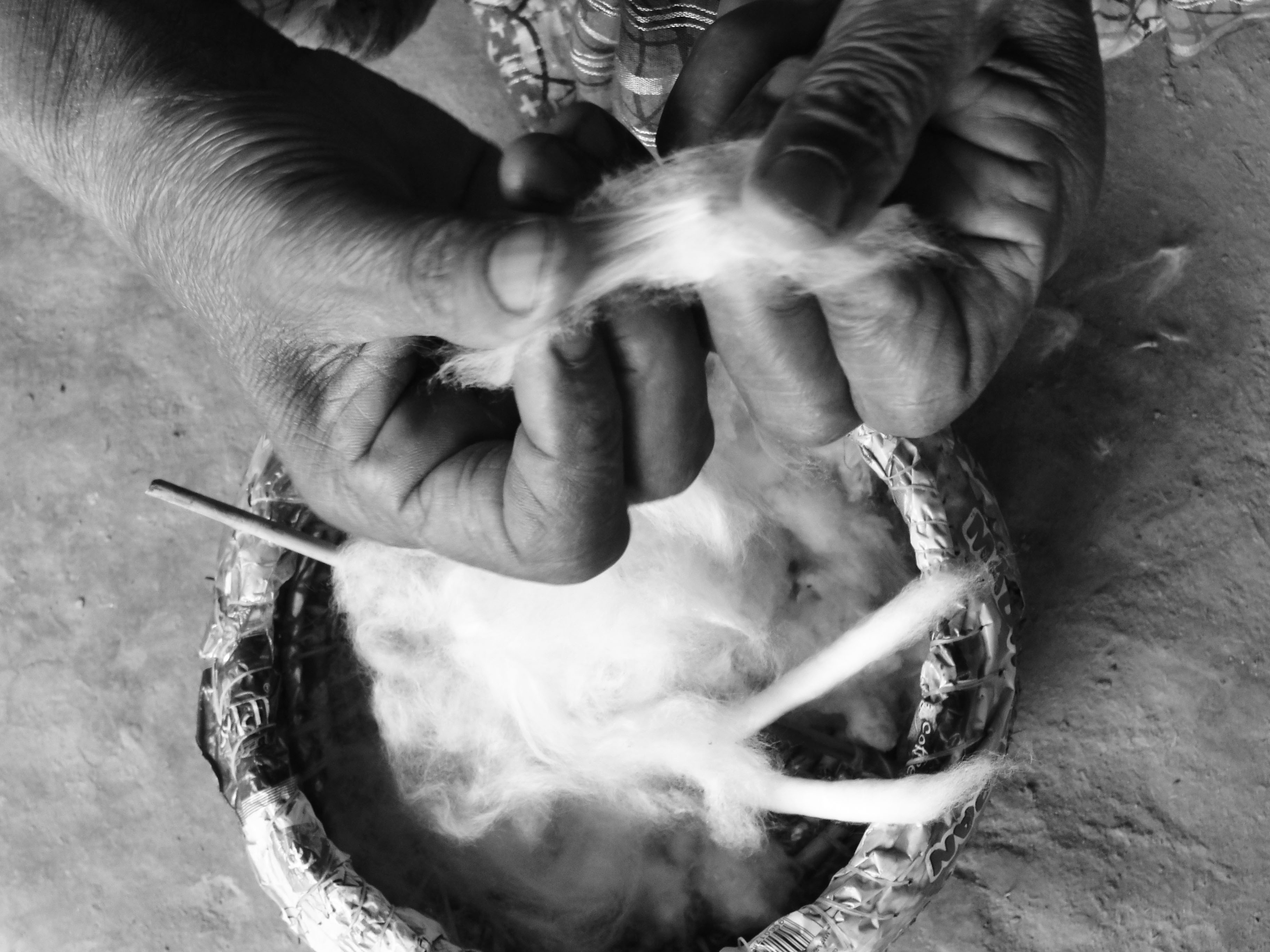
OPENING AND CLEANING OF THE BALED COTTON happens when the fibre is cleaned and ginned by hand to minimize damage and maintain the extra cleanliness necessary for hand-spinning the finest yarns.
OPENING AND CLEANING OF THE BALED COTTON happens when the fibre is cleaned and ginned by hand to minimize damage and maintain the extra cleanliness necessary for hand-spinning the finest yarns.
OPENING AND CLEANING OF THE BALED COTTON happens when the fibre is cleaned and ginned by hand to minimize damage and maintain the extra cleanliness necessary for hand-spinning the finest yarns.
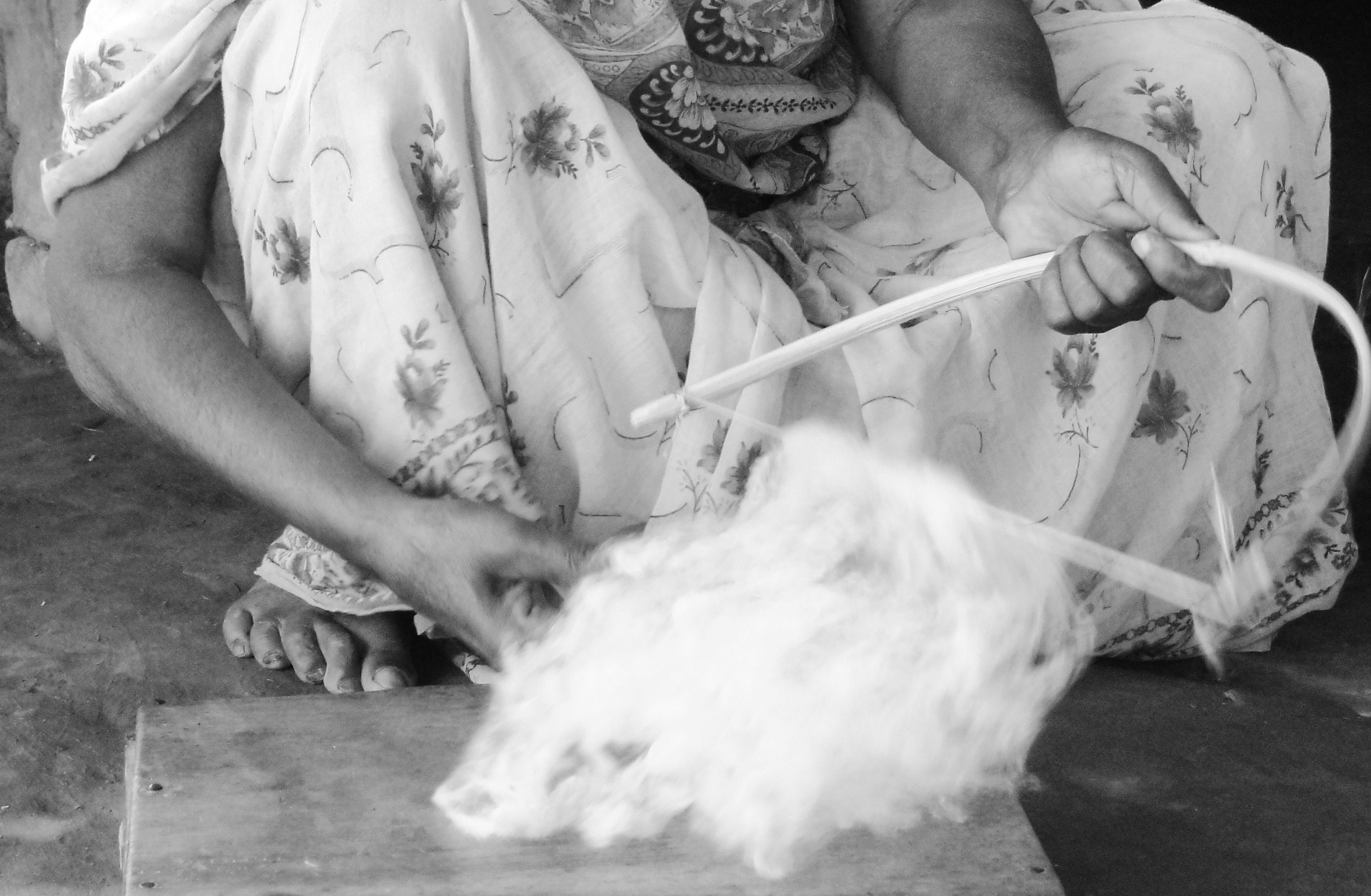
Hand-carding the cotton is the cornerstone of the cotton’s pre-spinning processes. Hand-carding is done on a wooden carding bow, a slow process that gives the most gentlest effect.
Final traces of trash are removed completely and fibres are then separated into a loose airy mass. After bow carding, the mass of separated fibres is gently rolled and collected as a “sliver”, a ready-to-use form for spinning on a traditional wheel.
Hand-carding the cotton is the cornerstone of the cotton’s pre-spinning processes. Hand-carding is done on a wooden carding bow, a slow process that gives the most gentlest effect.
Final traces of trash are removed completely and fibres are then separated into a loose airy mass. After bow carding, the mass of separated fibres is gently rolled and collected as a “sliver”, a ready-to-use form for spinning on a traditional wheel.
Hand-carding the cotton is the cornerstone of the cotton’s pre-spinning processes. Hand-carding is done on a wooden carding bow, a slow process that gives the most gentlest effect.
Final traces of trash are removed completely and fibres are then separated into a loose airy mass. After bow carding, the mass of separated fibres is gently rolled and collected as a “sliver”, a ready-to-use form for spinning on a traditional wheel.

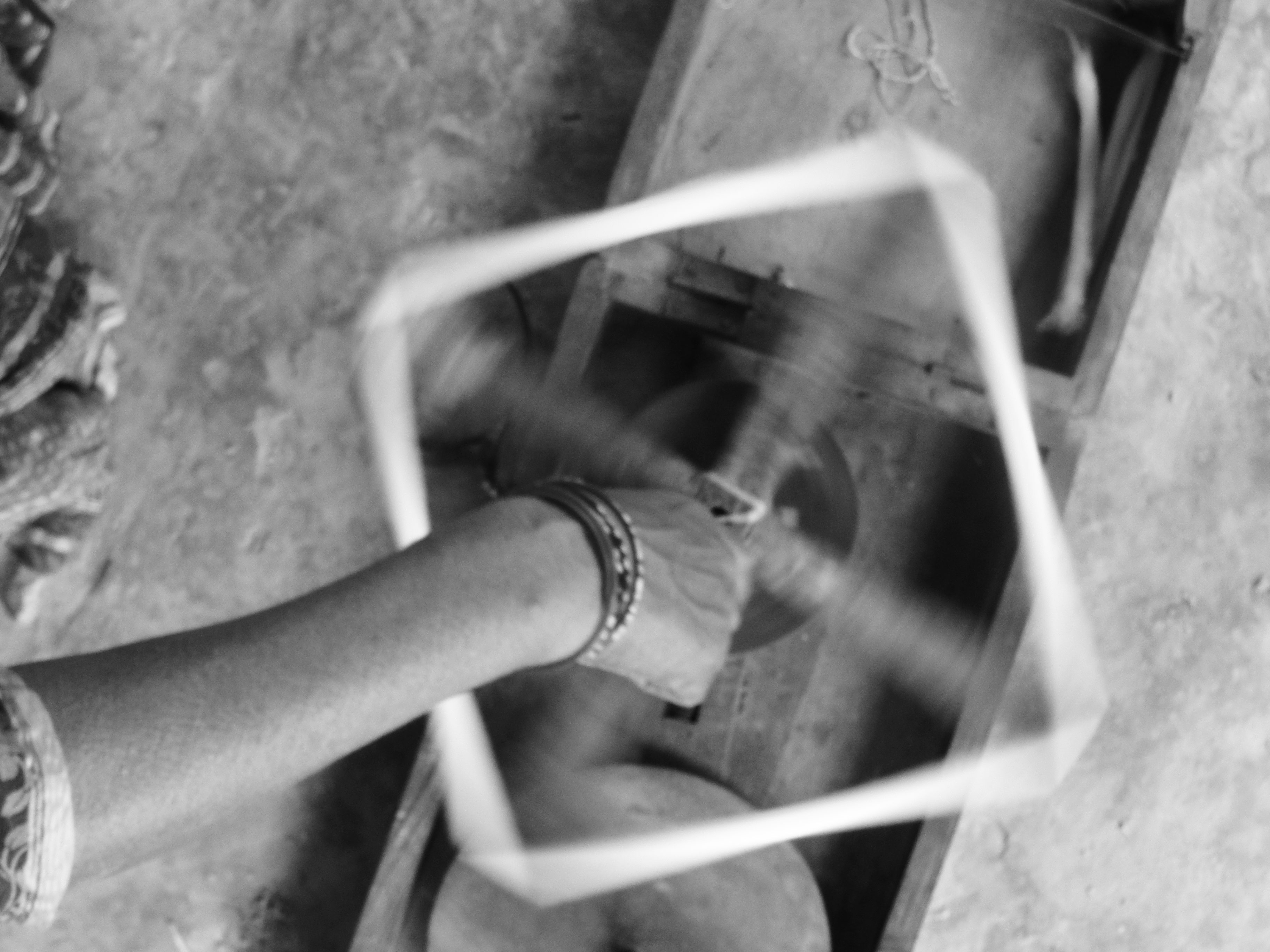
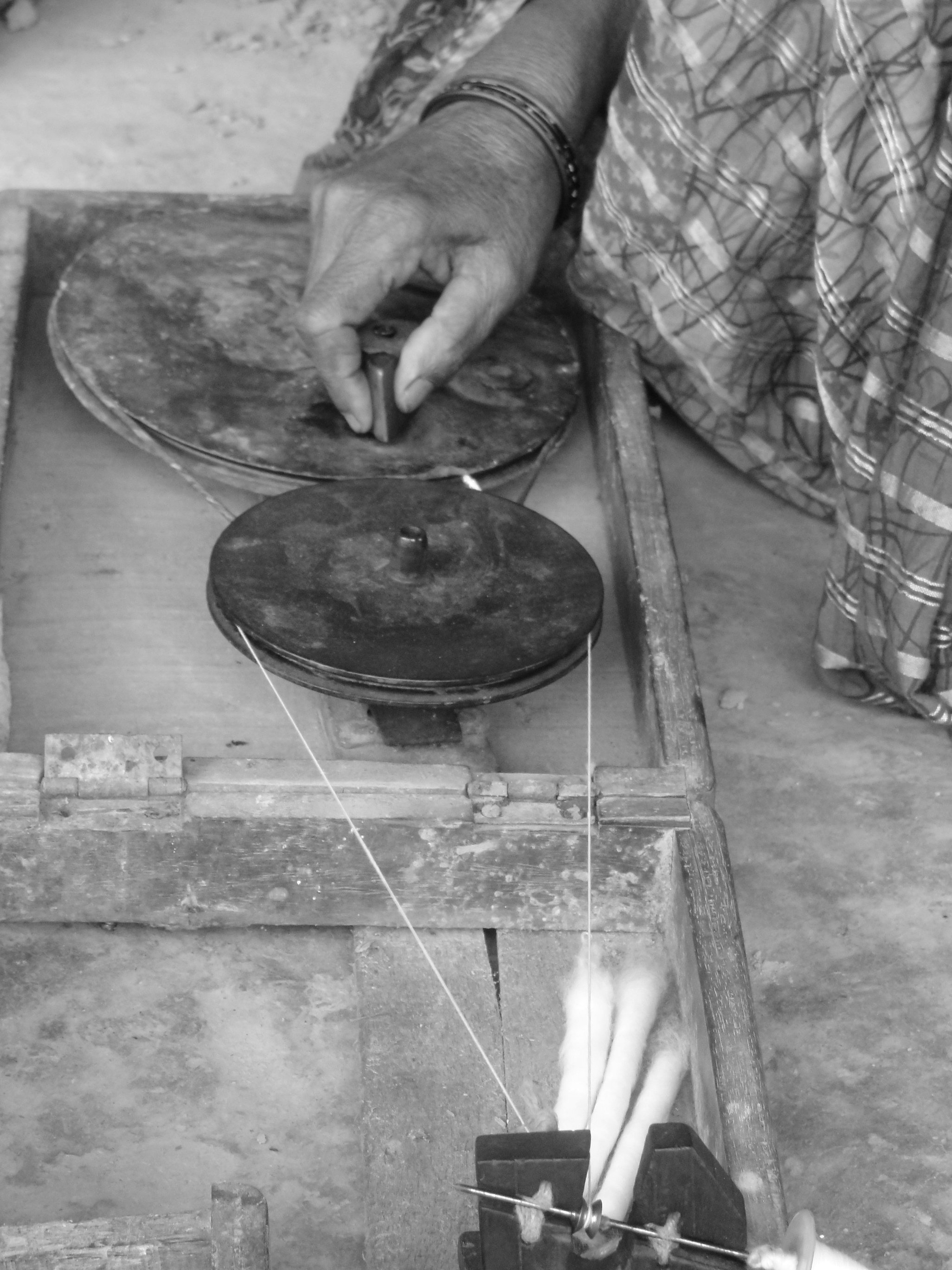
DURING THE ACT OF SPINNING, a stream of fibre is drawn from the sliver, along with twisting them to hold together and impart strength to the yarn. Spinning is done on a Charkha where the yarn is thinned out and twisted at the same time. Khadi yarns offer a wider range of counts than mill made yarns and can be hand spun up to the fineness of 500 counts.
When the spinning process is done, the yarn is then wounded into yarn hanks and prepared for dyeing.
DURING THE ACT OF SPINNING, a stream of fibre is drawn from the sliver, along with twisting them to hold together and impart strength to the yarn. Spinning is done on a Charkha where the yarn is thinned out and twisted at the same time. Khadi yarns offer a wider range of counts than mill made yarns and can be hand spun up to the fineness of 500 counts.
When the spinning process is done, the yarn is then wounded into yarn hanks and prepared for dyeing.
DURING THE ACT OF SPINNING, a stream of fibre is drawn from the sliver, along with twisting them to hold together and impart strength to the yarn. Spinning is done on a Charkha where the yarn is thinned out and twisted at the same time. Khadi yarns offer a wider range of counts than mill made yarns and can be hand spun up to the fineness of 500 counts.
When the spinning process is done, the yarn is then wounded into yarn hanks and prepared for dyeing.

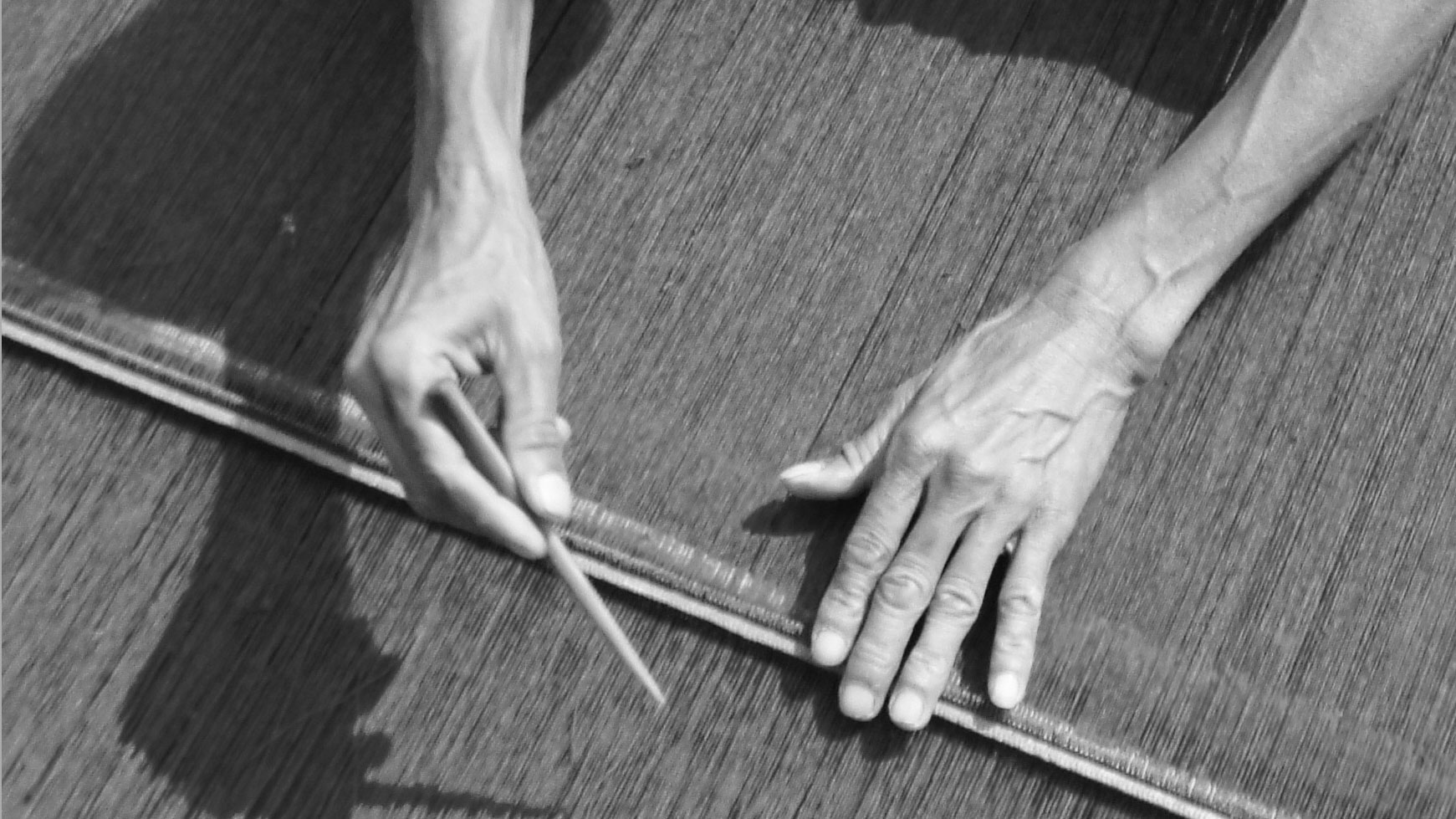
Warping & Sizing is done on lengths of 15 a 16 metres. The warp is then traditionally prepared by measuring out the yarn on wooden pegs inserted in the ground in weavers villages. After sizing the prepared warp, it is then stretched out to its full length in an outdoor space, a process known as “street sizing”.
Warping & Sizing is done on lengths of 15 a 16 metres. The warp is then traditionally prepared by measuring out the yarn on wooden pegs inserted in the ground in weavers villages. After sizing the prepared warp, it is then stretched out to its full length in an outdoor space, a process known as “street sizing”.
Warping & Sizing is done on lengths of 15 a 16 metres. The warp is then traditionally prepared by measuring out the yarn on wooden pegs inserted in the ground in weavers villages. After sizing the prepared warp, it is then stretched out to its full length in an outdoor space, a process known as “street sizing”.
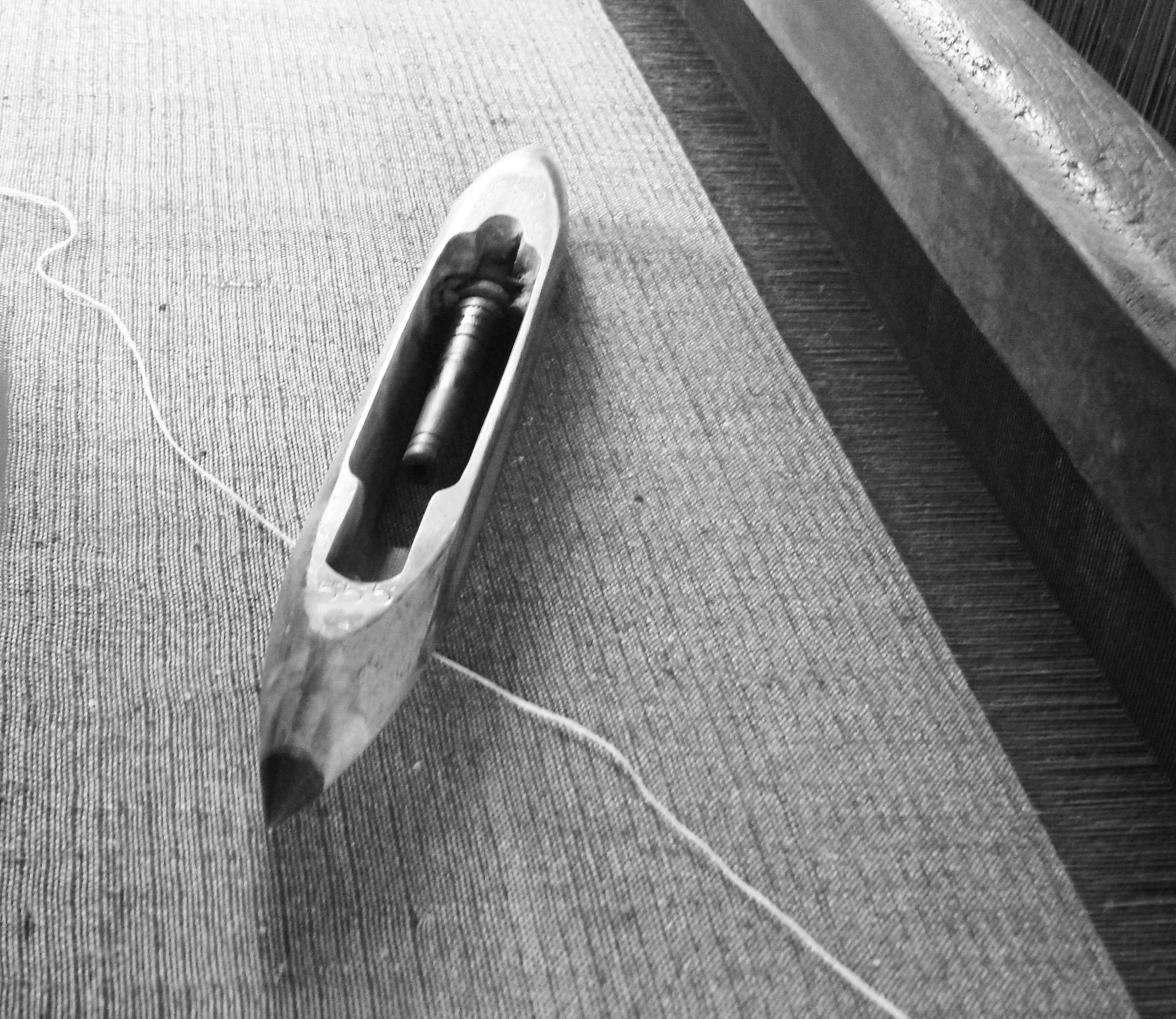
DRAWING & DRAFTING is the process of making the looping nylon wires around the warp ends, their position depends on the weave and design of the fabrics.
After this the warp is transferred from the warp beams to the pit looms a process that can take up to two days.
WEAVING OF KHADI is still mostly done on pit looms with a fly shuttle, which is one of the most ancient type of looms. The traditional loom is dug into the ground of the weavers’ houses where the artisan himself sits in a pit below ground level.
This mechanism is remarkably sturdy and capable of producing all weights of fabrics.
DRAWING & DRAFTING is the process of making the looping nylon wires around the warp ends, their position depends on the weave and design of the fabrics.
After this the warp is transferred from the warp beams to the pit looms a process that can take up to two days.
WEAVING OF KHADI is still mostly done on pit looms with a fly shuttle, which is one of the most ancient type of looms. The traditional loom is dug into the ground of the weavers’ houses where the artisan himself sits in a pit below ground level.
This mechanism is remarkably sturdy and capable of producing all weights of fabrics.
DRAWING & DRAFTING is the process of making the looping nylon wires around the warp ends, their position depends on the weave and design of the fabrics.
After this the warp is transferred from the warp beams to the pit looms a process that can take up to two days.
WEAVING OF KHADI is still mostly done on pit looms with a fly shuttle, which is one of the most ancient type of looms. The traditional loom is dug into the ground of the weavers’ houses where the artisan himself sits in a pit below ground level.
This mechanism is remarkably sturdy and capable of producing all weights of fabrics.



